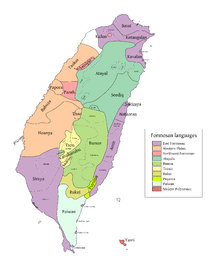Kulon language
| Pazeh | |
|---|---|
| Native to | Taiwan |
| Ethnicity | Pazeh people |
| Extinct | 24 October 2010, with the death of Pan Jin-yu |
| Dialects |
|
| Language codes | |
| ISO 639-3 | |
| Glottolog | kulo1237 |

(pink, northwest) Saisiyat, Pazeh proper, and Kulon. Some Chinese-language sources designate the white area in the northwest as a Kulon area, as opposed to the small pink circle on this map.
|
|
Pazeh (also spelled Pazih, Pazéh) is the extinct language of the Pazeh, a Taiwanese aboriginal people. It was a Formosan language of the Austronesian languages language family. The last remaining native speaker of Pazeh proper, Pan Jin-yu, died in 2010 at the age of 96. Before her death, she offered Pazeh classes to about 200 regular students in Puli and a small number of students in Miaoli and Taichung. Kulun (sometimes also spelled Kulon) was a dialect that became extinct earlier. The insulting name "fan" was used against Plains Aborigines by the Taiwanese, and the Hoklo Taiwanese speech was forced upon Aborigines like the Pazeh. Hoklo Taiwanese has replaced Pazeh and driven it to near extinction. Aboriginal status has been requested by Plains Aboriginals.
Pazeh has 17 consonants, 4 vowels, and 4 diphthongs (-ay, -aw, -uy, -iw).
Although Pazeh contrasts voiced and voiceless obstruents, this contrast is neutralized in final position for labial and velar stops, where only /p/ and /k/ occur respectively (/d/ is also devoiced but a contrast is maintained). /l/ and /n/ are also neutralized to the latter. Voiceless stops are unreleased in final position.
Mid vowels ([ɛ] and [o]) are allophones of close vowels (/i/ and /u/ respectively).
/a/ is somewhat advanced and raised when adjacent to /i/. Prevocally, high vowels are semivocalized. Most coronal consonants block this, although it still occurs after /s/. Semivowels also appear post-vocally.
...
Wikipedia
